Kristen takes a moment to reflect on the release of Amonkhet Remastered, released August 13 on Magic: Arena.
The release of Amonkhet Remastered last week gave rise to some mixed emotions for me, and mixed emotions I’m sure for the player base at large. For a set so recent—only three years ago—and a plane that in many ways was a trope-plane, one of the easiest to get wrong (see Throne of Eldraine), Amonkhet block managed to leave a mark on Magic players. It’s left enough of a mark that the nostalgia for better times has felt like one of the main driving points behind the marketing of the set.
What drives the nostalgia for Amonkhet Remastered, though? Amonkhet is only three years old, after all.
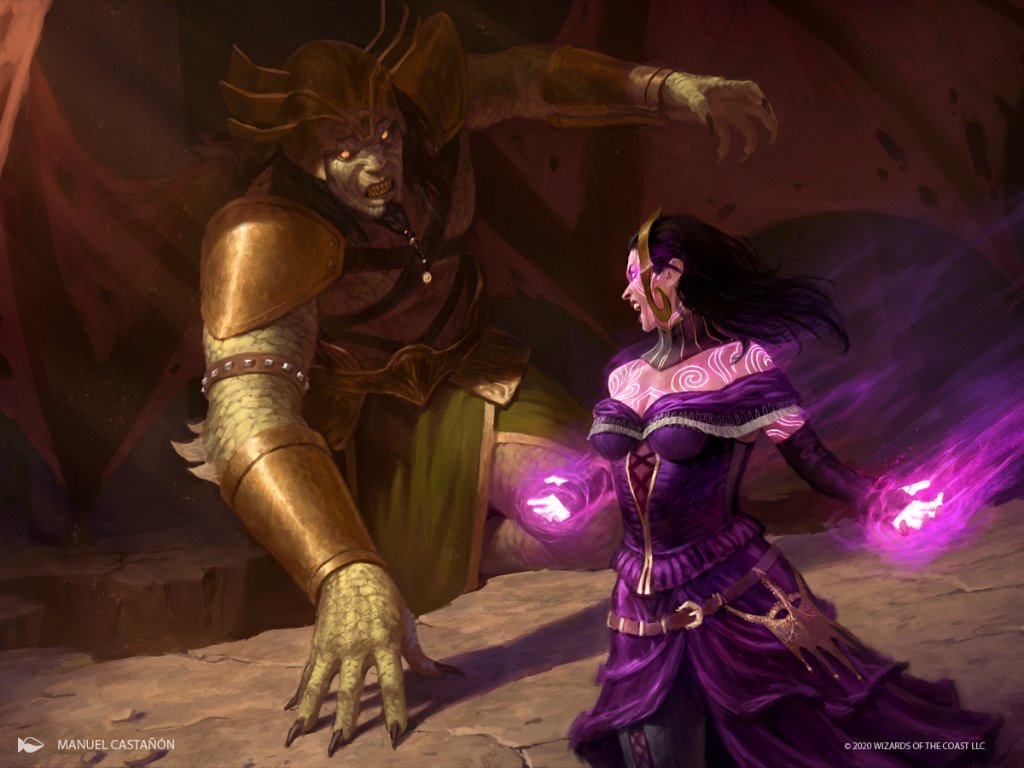
Liliana fights Razaketh, Manuel Castañón
Magic Story was Different in Amonkhet
I think one of the biggest nostalgia hooks for many invested in the overall Magic multiverse is the story, and there’d be little argument if I was to suggest that Magic Story was cresting to a peak in the time of Amonkhet and Hour of Devastation, eventually peaking with the fantastic Ixalan narrative. I last wrote about my issues with losing the thread of Magic’s story in May, dissatisfied with how Ikoria played out after the absolute wash-out of War of the Spark the year before.
Little has changed since then—I’m still hungering for a deeper narrative. The lost opportunities of Theros are still fresh in my mind, partially because I’m also still playing Assassin’s Creed: Odyssey. I’m on the final stretch, I think, and in exploring Elysium and being cast down to Hades, I’ve again ruminated on the lost potential for Elspeth’s story. The very idea of conquering death is a tantalizing idea for a story, but unfortunately what we got was as shallow as her grave.
While sagas like The Birth of Meletis and The First Iroan Games might be mechanically satisfying, we get no real confirmation as to their relevance to the story. Even cards we know are relevant to the story, like the eponymous Elspeth Conquers Death, offer scant insight into how the story played out. What enemy did she defeat as she began her ascent, before culminating in her return?
Contrast this with the mechanical storytelling on cards during the Amonkhet era. The foreshadowing at the end of Kaladesh block that pointed out that this particular excursion would not go well if they didn’t heed Ajani’s missive of patience was a masterstroke. We got that foreshadowing on the cards in the set:
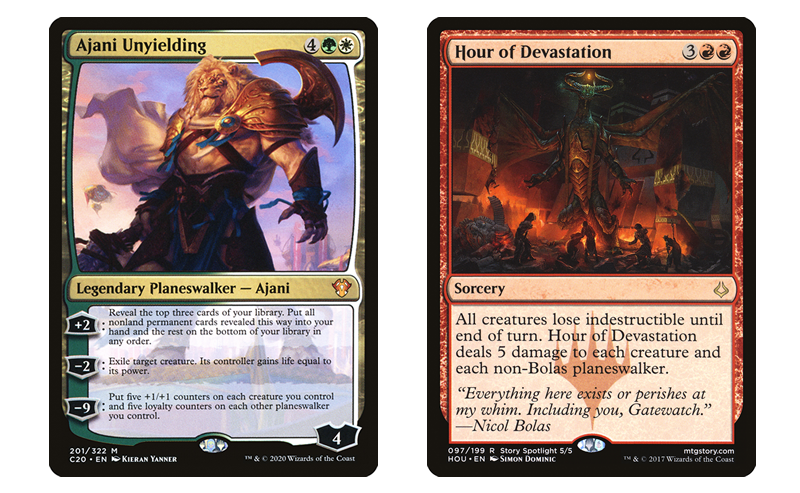
I still think it’s beautiful that the hubris of the Gatewatch is reflected in the mechanics of the cards; had the Gatewatch teamed up with Ajani, their mission may have been a success. Just look at how the Ultimate on Ajani, Unyielding negates the damage of Hour of Devastation. It’s poetic! At risk of going off topic further to talk about the card design of this era, I’ll end this little tangent by summarizing that I think that, though ham-fisted in places, the card-design-meets-flavor was particularly strong during this era. For every “it’s Emrakul, duh!” card we got, we also got a superb design like Nahiri, the Harbinger, which reflected the cards’ place in the story. Cards like Hour of Promise in Hour of Devastation fit this mold; the idea that the encroaching desert brought threats was a very real way to represent the narrative.
Amonkhet block’s pride before a fall narrative was straight out of the hero’s journey, but taking from that playbook is never necessarily a bad thing. In fact, this particular excursion was a much needed hurdle for the seemingly unstoppable heroes of the Gatewatch, who until this point had managed to achieve all they had set out to. Amonkhet delivered in many ways, not least in sating the many complaints that our “Avengers” were skating too close to Mary-Sue & Marty-Sam levels of blandness.
On another axis, the micro-narratives of Amonkhet block were also particularly great. Gideon’s struggle with faith in James Wyatt’s Trust, and his later journey through the trials were great examples of character development and wrestling with complex issues. The story in Hour of Devastation was also of high quality, giving us some character development and potential rifts in the team when Liliana took down Razaketh, which sowed the seeds for the devastating finale. Though the story was largely in-house at this time, and not wholly commissioned to external writers, it was good. There was passion behind it, it stuck largely to what we knew about how the world of Magic worked, and it managed to show our beloved characters behaving as we would expect them to—with few crazy retcons, if there were any at all.
Magic was Different in Amonkhet
Magic itself was also different during Amonkhet block. We’d hit the point of reset for Standard, and, going into the Ixalan block that would follow, the cards in Standard would see a reduction in power level after the more pushed Kaladesh block. As Magic players, it’s easy to complain about weaker constructed cards; at the time, there were many complaints. These would eventually be pushed out by the complaints about card bannings, but one facet of nostalgia that must be considered is that we often forget the less rosy aspects of what we’re looking back on.
Still, with Standard in the position it’s in today, it’s easy to see why so many players are feeling nostalgia for Amonkhet. That was a time when the most broken card in Standard was a land that could shock you, and a time when seven different decks made it to the top eight of Pro Tour Ixalan. I certainly can remember building Ramunap Red in paper, and it was a blast to play. That’s one thing I remember about this era too: paper Magic.
Never mind the fact that we had GP Coverage and paper Pro Tour tournaments, we also had Game Day. Being a big fish in a small pond is what fuels the ambition to go further in tournament play; beyond that, events like Game Day and Store Championships provided a little competitiveness to the calendar for the average casual player. These events kept people invested in keeping a budget Standard deck built, or learning the draft formats. They gave people something to aim for—even if they couldn’t Day 2 a Grand Prix, making Top 8 of a Game Day might have been all the glory they needed to feel good about themselves.
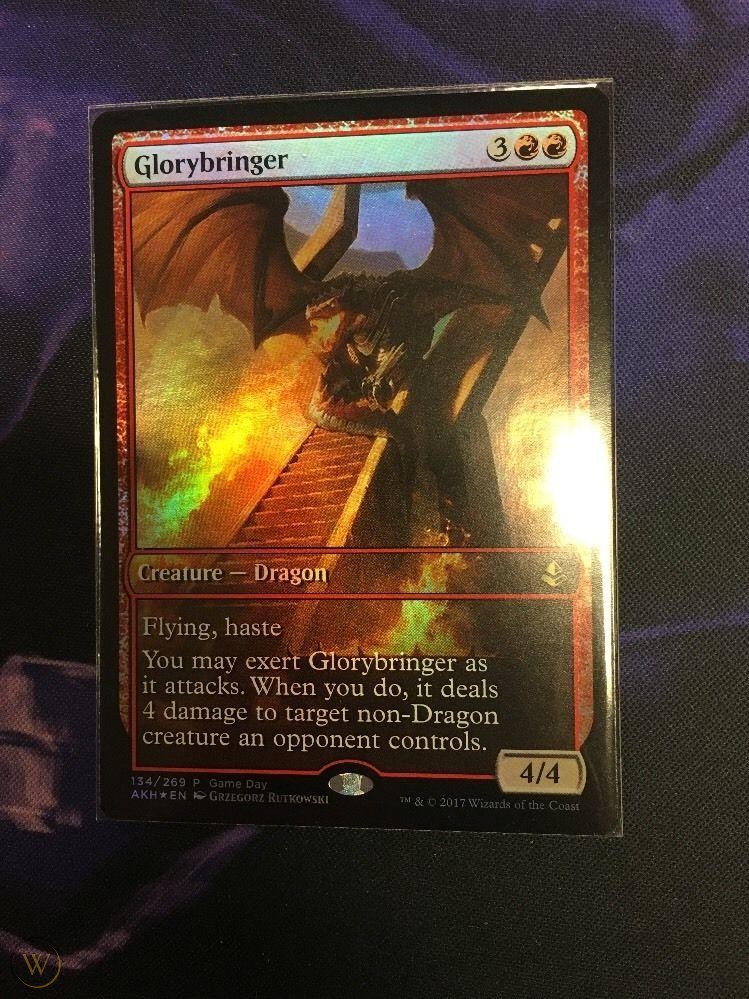
Top 8 Game Day Amonkhet Promo Glorybringer
Paper Magic is something everyone misses right now, and it’s no wonder that people are feeling the warm and fuzzies for playing Amonkhet again. It brings back warm memories of Paper magic in the before-times. And, you know, Game Day promo cards. Those were cool. Back when full art cards were the exception, and not the norm. As an aside, I think I do prefer my full art treatments in this style with a frame, but that’s just me.
The Second Sun
So, Amonkhet Remastered eh? As the Second Sun approaches and we look to enjoy this reprint set, there are a few key things that immediately set the tone for this experience. The first is that the compilation of cards we’re getting is not complete. More than draft commons are missing, though—entire archetypes and powerful enablers are missing too. From cards like Flameblade Adept and Regal Caracal, a card many Historic Cats players wanted access to, to iconic build-arounds like Bounty of the Luxa, many cards are missing from the bumper edition that is Amonkhet Remastered. I can see draft staples I used to love that aren’t going to be included, like Dreamstealer, Devoted Crop-mate, Angler Drake, River Serpent, Fling.
Our second time experiencing Amonkhet will undoubtedly be different than our first. This remaster has a lot in common with the nostalgia around videogames in general. The first time you played an MMO, or a game like Overwatch, was lightning in a bottle; you’ll never be able to play that same game again. The game will have been patched, the metagame will be different, and the people you played with will no longer be around in many cases. Amonkhet Remastered is similar—the metagame has shifted with it being a combined set; with certain cards unavailable, it’s akin to being patched; and, unlike before, you’ll not be able to enjoy this set on paper with your draft group. Amonkhet had its time in the sun, and so did we.
When you throw in the fact that many who played the Beta had built up a collection of Amonkhet block cards, and lost them in the transition to the full release of Magic: Arena, frustrations in many ways start to boil over. Re-releasing a set that many had collected and had taken away feels like a kick in the teeth.
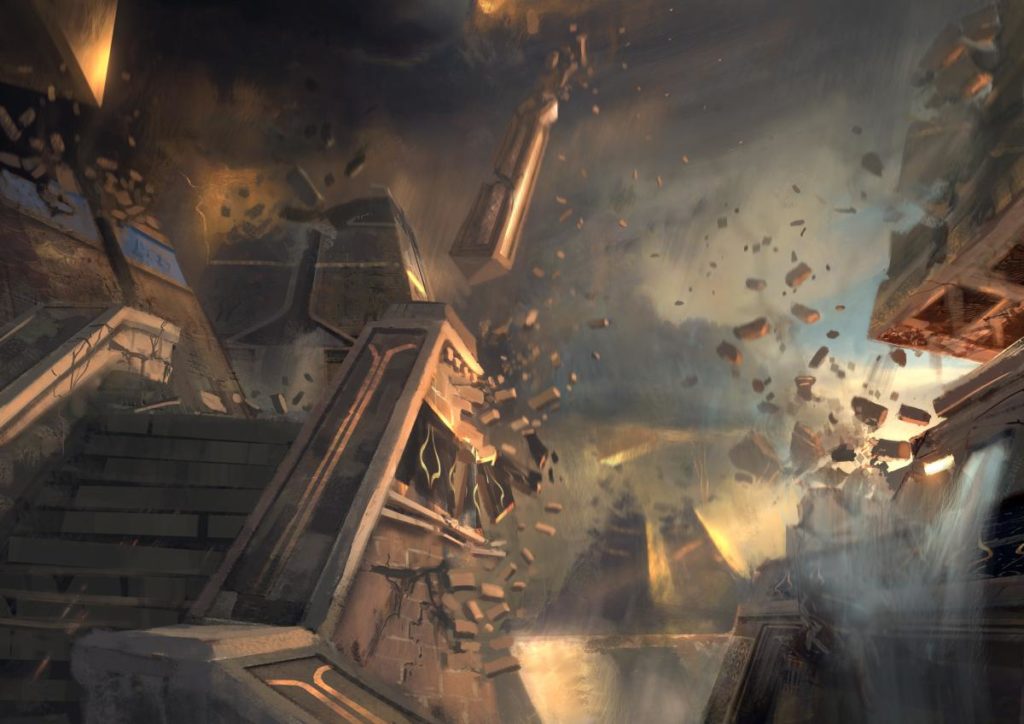
Sunder by Titus Lunter
Erosion & Decay
In many ways, talking about nostalgia for better times seems apt when we’re looking at Amonkhet Remastered. Amonkhet as a plane has themes of decay and erosion by merit of being a sandy desert plane. The building up mechanics on cards like Pyramid of the Pantheon are mirrored starkly by Sunset Pyramid, with the last brick counter’s removal signalling that the power is spent. -1/-1 counters are another big part of Hour of Devastation, and likewise symbolize the “long defeat.” A concept Tolkien uses in his works, the idea of the long defeat is that decline and decay are inevitable, and it’s our hope and unity that propel us forward even as we slide toward the bitter end. We can’t recapture yesterday, but we can make today matter. In Amonkhet, Bolas is inevitable, and only the unity and passion of those like Samut and Hazoret can stand in the way of Amonkhet’s apocalypse.
We later learn that their trials were not in vain, as we see those saved by Hazoret forming a resistance. After the events of War of the Spark, it’s safe to assume that the world seeks to rebuild. Much like in the works of Tolkien, the new Amonkhet will be built on the ruins of another, which was built on the ruins of another still. The nostalgia of Tolkien is both fatalistic but hopeful, and it explores both the resigned stoicism necessary to shoulder the burden of hard times in the face of inevitable hardship, but also the strength found in hope and fighting for what matters.
Our pandemic-stricken lives right now feel like a long defeat. Everything we know has changed, and it feels like the light at the end of the tunnel is ever moving beyond the horizon. Whether or not we think our world is in decline is irrelevant, because what matters now is that we should face things with full, unapologetic engagement.
“If anything, we find that most of the characters in LOTR cast their whole hearts into their endeavors. What they love is on the line: their friends and family, their gardens, a mug of ale in the company of friends. They hope and long for these things to be protected and offer themselves as sacrifices to make it so.”
Things aren’t much different for those of us who are socially isolated, and nostalgia for the days of Amonkhet is sure to leave us drifting from the hope that things will improve. Magic has changed. It’s played on Arena, in isolation, and the cards and sets of yesteryear are in many ways in the rear view mirror. While it’s true that we’ll not be able to recapture the memories of original Amonkhet, we can still enjoy and celebrate things with Amonkhet Remastered. It’s not the same, no, but it’ll manage to put a smile on your face seeing those cards again—and that’s worth it.
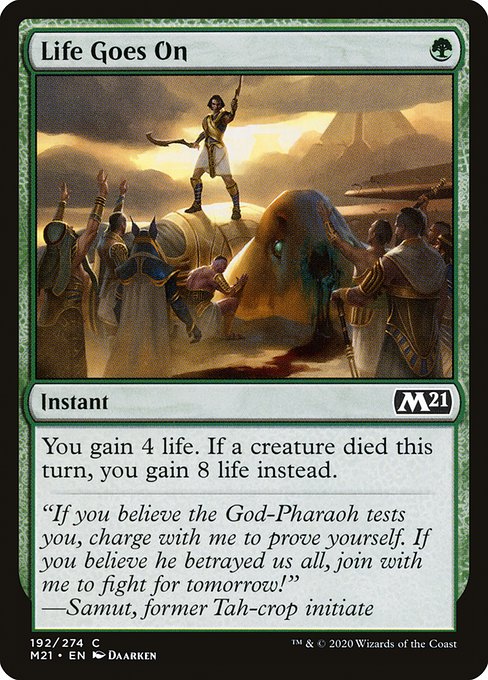
Now, more than ever, it’s what we make of Magic that truly defines it. For many, that’s the Gathering, and playing on webcam with friends in distant lands—or even those same friends living across the city that they can’t see. In spite of the stress, and the tragedy, and the injustice of things, we must hold true to ourselves and what we hold dear. And, like those rebuilding Amonkhet, we have no choice but to keep going even when we feel we can’t.
Life Goes On.
Based in the UK, Kristen is a lover of both Limited and Commander, and can most often be found championing the Boros Legion when called upon to sit down and shuffle up.

